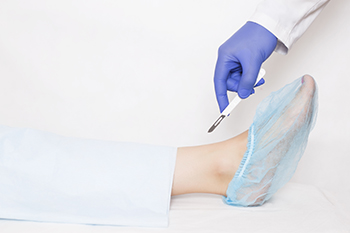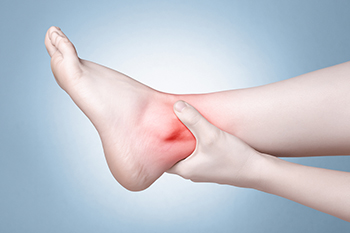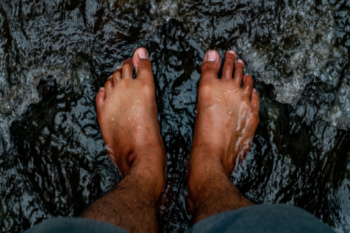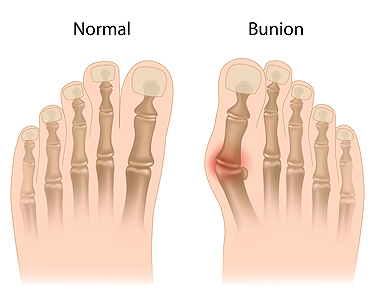Connect With Us
Blog
Items filtered by date: October 2025
Stepping Forward With Confidence After Total Ankle Replacement

Total ankle replacement is a surgical procedure designed to relieve pain and restore movement for people with severe ankle arthritis or injury. During the procedure, damaged bone and cartilage are replaced with artificial components that mimic the natural joint, allowing smoother motion and better flexibility. Unlike ankle fusion, which limits movement, this advanced technique preserves joint mobility and can improve overall balance and gait. Recovery takes time and involves targeted exercises to strengthen muscles and improve the range of motion. Wearing supportive footwear and a gradual return to activity can help protect the new joint. Many patients experience significant pain relief and improved quality of life after surgery. If chronic ankle pain or stiffness limits your ability to walk comfortably, it is suggested that you consult a podiatrist who can evaluate whether total ankle replacement is the right option to help you move freely again.
In certain cases, in which the patient suffers from extreme pain or damage in a joint, joint replacement surgery may be deemed useful. If you have constant pain in a foot joint, consult with Josef Elouze, DPM from Elite Podiatry. Our doctor will assess your condition and provide you with quality foot and ankle treatment.
What Is Joint Replacement Surgery?
Over time, joints wear down; this can be exacerbated by diseases and conditions. Joint replacement surgery, also known as arthroplasty, is when a damaged joint is surgically removed and replaced with a prosthesis. Prostheses, which can be made of ceramic, plastic, or metal, act as joints in lieu of an actual joint. One of the most prevalent causes for joint replacement is arthritis.
Arthritis in the Foot
Arthritis can occur in any joint in the body, including in the feet. Common types of arthritis in the foot are osteoarthritis, rheumatoid arthritis, and gout. The big toe is usually where arthritis occurs in the foot; this is known as hallux rigidus.
Joint Replacement Surgery in the Foot
The most common form of joint replacement in the foot is a first metatarsophalangeal (MTP) joint placement. MTP joint replacement surgery is designed to treat hallux rigidus. Surgery is not intensive, and recovery occurs within one to two months after the procedure has been done. Overall, joint replacement surgery is a safe and effective way to treat pain in the joint of the foot.
If you have any questions, please feel free to contact our office located in (Holiday City) Toms River, NJ . We offer the newest diagnostic and treatment technologies for all your foot care needs.
Understanding Ankle Pain When Walking

Ankle pain while walking can be caused by several conditions, including gout, osteoarthritis, and peripheral neuropathy. Gout is a form of inflammatory arthritis caused by a buildup of uric acid crystals in the joint, leading to sudden, intense pain, swelling, and redness. Osteoarthritis results from the gradual wear and tear of cartilage, causing stiffness, aching, and decreased mobility in the ankle joint. Peripheral neuropathy involves nerve damage, often due to diabetes or other medical conditions, and can cause burning, tingling, or numbness in the ankle and foot. The pain may feel sharp, throbbing, or burning and can worsen with activity. A podiatrist can provide an accurate diagnosis through a physical examination, medical history review, and imaging or nerve studies. Treatment options may include medication, lifestyle modifications, orthotics, o,r in some cases, surgery. To address ankle pain effectively and improve mobility, it is suggested that you schedule an appointment with a podiatrist.
Ankle pain can have many different causes and the pain may potentially be serious. If you have ankle pain, consult with Josef Elouze, DPM from Elite Podiatry. Our doctor will assess your condition and provide you with quality foot and ankle treatment.
Ankle pain is any condition that causes pain in the ankle. Due to the fact that the ankle consists of tendons, muscles, bones, and ligaments, ankle pain can come from a number of different conditions.
Causes
The most common causes of ankle pain include:
- Types of arthritis (rheumatoid, osteoarthritis, and gout)
- Ankle sprains
- Broken ankles
- Achilles tendinitis
- Achilles tendon rupture
- Stress fractures
- Tarsal tunnel syndrome
- Plantar fasciitis
Symptoms
Symptoms of ankle injury vary based upon the condition. Pain may include general pain and discomfort, swelling, aching, redness, bruising, burning or stabbing sensations, and/or loss of sensation.
Diagnosis
Due to the wide variety of potential causes of ankle pain, podiatrists will utilize a number of different methods to properly diagnose ankle pain. This can include asking for personal and family medical histories and of any recent injuries. Further diagnosis may include sensation tests, a physical examination, and potentially x-rays or other imaging tests.
Treatment
Just as the range of causes varies widely, so do treatments. Some more common treatments are rest, ice packs, keeping pressure off the foot, orthotics and braces, medication for inflammation and pain, and surgery.
If you have any questions please feel free to contact our office located in (Holiday City) Toms River, NJ . We offer the newest diagnostic tools and technology to treat your foot and ankle needs.
Understanding Hammertoe

Hammertoe is a condition where one or more toes bend abnormally at the middle joint, creating a curled or claw-like appearance. This often happens when muscles and tendons in the toe become imbalanced, pulling the joint into the wrong position. Wearing tight or ill-fitting shoes, high heels, or inherited foot structure can all play a role in its development. At first, hammertoe may cause only mild discomfort, but over time, it can lead to pain, corns, calluses, or difficulty wearing certain shoes. The affected toe may also become stiff, making it harder to move. Treatment depends on how advanced the condition is. Early care can include wearing shoes with a wide toe box, using pads or orthotics, and doing simple stretching exercises. In more severe cases, surgery may be needed to straighten the toe. If you are experiencing pain or changes in your toes, it is suggested that you see a podiatrist for expert advice and guidance.
Hammertoe
Hammertoes can be a painful condition to live with. For more information, contact Josef Elouze, DPM from Elite Podiatry. Our doctor will answer any of your foot- and ankle-related questions.
Hammertoe is a foot deformity that affects the joints of the second, third, fourth, or fifth toes of your feet. It is a painful foot condition in which these toes curl and arch up, which can often lead to pain when wearing footwear.
Symptoms
- Pain in the affected toes
- Development of corns or calluses due to friction
- Inflammation
- Redness
- Contracture of the toes
Causes
Genetics – People who are genetically predisposed to hammertoe are often more susceptible
Arthritis – Because arthritis affects the joints in your toes, further deformities stemming from arthritis can occur
Trauma – Direct trauma to the toes could potentially lead to hammertoe
Ill-fitting shoes – Undue pressure on the front of the toes from ill-fitting shoes can potentially lead to the development of hammertoe
Treatment
Orthotics – Custom made inserts can be used to help relieve pressure placed on the toes and therefore relieve some of the pain associated with it
Medications – Oral medications such as anti-inflammatories or NSAIDs could be used to treat the pain and inflammation hammertoes causes. Injections of corticosteroids are also sometimes used
Surgery – In more severe cases where the hammertoes have become more rigid, foot surgery is a potential option
If you have any questions, please feel free to contact our office located in (Holiday City) Toms River, NJ . We offer the newest diagnostic and treatment technologies for all your foot care needs.
Are Bunions Affecting Your Everyday Life?
Why Do Bunions Develop?
 A bunion is a foot condition where there is a bony protrusion on the side of the big toe. It can develop as a result of genetic factors or from wearing shoes that do not have adequate room for the toes to move freely in. Larger shoes may need to be purchased for existing bunions, and it may be difficult to walk. Additionally, patients may notice the affected joint has become stiff and red, and it may be challenging to maintain balance. Specific foot stretches and exercises may be beneficial in improving general foot function by strengthening the muscles, tendons, and ligaments. Wearing custom-made orthotics may help to reduce the discomfort from having a bunion, and toe separators may help to alleviate a portion of the pain. If you have a painful bunion, it is suggested that you make an appointment with a podiatrist who can recommend treatment options, which may include surgery for permanent removal.
A bunion is a foot condition where there is a bony protrusion on the side of the big toe. It can develop as a result of genetic factors or from wearing shoes that do not have adequate room for the toes to move freely in. Larger shoes may need to be purchased for existing bunions, and it may be difficult to walk. Additionally, patients may notice the affected joint has become stiff and red, and it may be challenging to maintain balance. Specific foot stretches and exercises may be beneficial in improving general foot function by strengthening the muscles, tendons, and ligaments. Wearing custom-made orthotics may help to reduce the discomfort from having a bunion, and toe separators may help to alleviate a portion of the pain. If you have a painful bunion, it is suggested that you make an appointment with a podiatrist who can recommend treatment options, which may include surgery for permanent removal.
If you are suffering from bunions, contact Josef Elouze, DPM of Elite Podiatry. Our doctor can provide the care you need to keep you pain-free and on your feet.
What Is a Bunion?
A bunion is formed of swollen tissue or an enlargement of boney growth, usually located at the base joint of the toe that connects to the foot. The swelling occurs due to the bones in the big toe shifting inward, which impacts the other toes of the foot. This causes the area around the base of the big toe to become inflamed and painful.
Why Do Bunions Form?
Genetics – Susceptibility to bunions are often hereditary
Stress on the feet – Poorly fitted and uncomfortable footwear that places stress on feet, such as heels, can worsen existing bunions
How Are Bunions Diagnosed?
Doctors often perform two tests – blood tests and x-rays – when trying to diagnose bunions, especially in the early stages of development. Blood tests help determine if the foot pain is being caused by something else, such as arthritis, while x-rays provide a clear picture of your bone structure to your doctor.
How Are Bunions Treated?
- Refrain from wearing heels or similar shoes that cause discomfort
- Select wider shoes that can provide more comfort and reduce pain
- Anti-inflammatory and pain management drugs
- Orthotics or foot inserts
- Surgery
If you have any questions, please feel free to contact our office located in (Holiday City) Toms River, NJ . We offer the newest diagnostic and treatment technologies for all your foot care needs.


